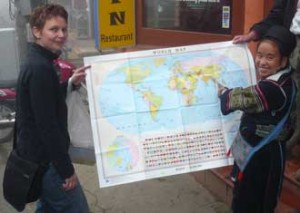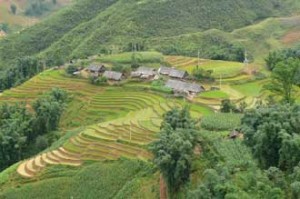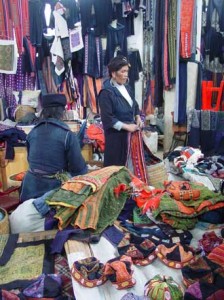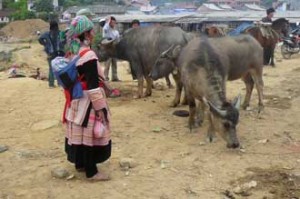
Livelihoods and trade across the Vietnam-China border
By Sarah Turner
“Wow, China’s big eh!?” Chi exclaims. I’m humbled as a geography professor to witness the excitement on this young Hmong woman’s face when she sees for the very first time on a map where Vietnam is and how big China – 35km from where we’re standing – is in comparison. We’re scrutinizing a freshly purchased world map that I’ve brought up from Vietnam’s capital Hanoi to the upland Northern Vietnam market town of Sa Pa, a day away by train and bus. Chi’s even more amazed at how far I’ve travelled from Canada to come and talk to her. But she quickly cottons on to the fact that the map is indeed a bad image of a round globe. “It’s not really flat, it’s more like this” I try to explain as I crumble up the map to form a messy ball, thinking to myself “got to bring some inflatable globes next year…”
Hmong people like Chi, as well as Yao, Tày, Nung and other ethnic minority groups, live in Lào Cai province, a remote upland region in Northern Vietnam where I’ve been undertaking fieldwork with colleagues and graduate students for the past ten years. This time I’ve come to Vietnam and China for five months of my sabbatical and as one of my current projects I’m keen to listen to a number of Hmong elders recount their histories of the past and how their livelihoods have changed over time.

A few days later my graduate student Christine Bonnin and I hop on the back of Hmong motorbike taxis and together with our young Hmong interpreter for the day, Be (who has taught herself spoken English from backpacker tourists visiting the area), head down the narrow valley road that snakes between rice terraces, hemp crops for making cloth, indigo patches (to dye the hemp), small family vegetable plots, and wooden Hmong houses. After we manage to run over a rather long snake en route and then trek by foot up the other side of the valley, we finally arrive at Be’s family house. Here we offer the pig fat and vegetables we’ve carried down from the local town market to Be’s father, Lue. Even though it’s just after Hmong New Year and Lue has recently slaughtered a pig in celebration, he’s happy to receive our gifts to boost his family’s food supplies.
Our timing is good and Lue has time to sit and chat for a while since it’s not yet the season to plough the fields for the rice and corn crops. Today Lue is keen to talk about the days when they grew opium poppies in the valley. The lowland Vietnamese and Chinese nearby were enthusiastic customers for this crop that grew well in the upland areas on the Chinese border. While often marginalized as opium producers throughout Southeast Asia, it’s got to be remembered that ethnic minority groups like the Hmong were introduced to this crop by the Chinese and French colonialists (and British elsewhere in Southeast Asia) so it’s hardly the fault of the minority residents of these mountainous areas that the trade thrived there for many years and still does in some areas. While Lue is not aware of how the opium arrived in the area, he certainly remembers the trade negotiations between local Hmong growers and eager lowland customers.
Also on Lue’s mind is the rice crop that his family will be planting shortly. He’s worried that the rice seeds that he’s just purchased from the state supplier are of poor quality and even if it’s a ‘high yield variety’ that the government has been trying to encourage ethnic minorities to plant for the past decade, Lue is very apprehensive that the crop will do well. Last year his cousin’s crop in another village nearby hardly germinated at all because the government seeds were not suitable for local climatic conditions.
The government did nothing to help those with failed crops and some families had to resort to eating food collected from the forest “like in the old days during the China war” recounts Lue, referring to the 1979 war when China invaded northern Vietnam to “teach Vietnam a lesson” for its military incursions into Cambodia. Lue would much prefer to plant ‘traditional’ Hmong rice as it tastes far better, if only he had enough land. After hearing a number of troubling stories like this Christine and I begin to realise that there is a worrying lack of dialogue and understanding between a government bent on improving rice output and upland ethnic groups struggling to maintain parts of their customary lifestyle. We feel it is important to raise awareness of these differences among the local non-governmental organisation community and soon start talking of such a project…

The next day back in the local market town I run into Chi – the new geographer – selling Hmong textiles in the market. These textiles were originally those made by her family, but these days enterprising Hmong scour the countryside to gain supplies as the demand from tourists for ‘authentic cultural artefacts’ has grown, a topic that I’ve been researching for a number of years. Chi explains how a lot of these textiles are now coming over the border from China, brought across by both China-based and Vietnam-based Hmong. This factors into another aspect of my research in the highlands, analysing the small-scale, cross-border trade of ethnic minorities who navigate the political realities of an international border that cuts their historical homeland in two.
A month later and I’m just across the border in Yunnan province, China, with another graduate student, Steeve Davieu; a colleague from anthropology at Université Laval, Jean Michaud; and our local research partner Bai Tingbin. After an hour on a winding gravel road in a minibus from the regional main town of Mǎ Guān, we get to a small border town. We make this trip because earlier, in a border market in Vietnam, I’d met a lot of traders from this Chinese town, many of whom are Han Chinese speaking excellent Hmong. This fact completely surprised my Hmong research assistant in Vietnam, who repeatedly exclaimed “but Kinh [lowland Vietnamese] people never learn Hmong!”
Once in this small Chinese town, not quite knowing what to do next as the heavy fog swirls around us, we soon meet Zou, a Han Chinese man who is very curious to know why on earth there are foreigners here on such a miserable day, or indeed on any day. Zou has lived here all his life, and quickly invites us back to his house on the main street for a chat. A cross-border smuggler for twenty years, to my amazement he starts to detail the tricks of the trade. What do people in China usually take across the border from this town to sell? “Oh mainly cigarettes, batteries, matches, textiles, medicine, flashlights, those sorts of things,” he says. Where would you cross the border and what would happen if you were caught? “We crossed at the local checkpoint, and if we were caught then the police would take our goods, so we’d run like crazy and try to hide.”

Knowing that there is a large buffalo market in the vicinity, I ask about the cross-border trade of these precious beasts of burden, used by ethnic minorities to plough their rice and corn fields. Zou recalls that until two years prior, most of the buffalo trade went from China to Vietnam, but since two years it’s switched around, and people from Vietnam, mainly ethnic minorities, are bringing buffalo to China to sell. This correlates exactly with what Hmong buffalo traders had told me earlier that month in Can Cau, a border market over in Vietnam, where one buffalo trader had had to cut short our conversation because he and his buffalo were heading over to China ‘via a secret route.’
When I talk with ethnic minority people in Vietnam and China I find that their livelihood decisions are not always those that outsiders such as local government officials, aid agencies, or academics think they would or should be, be it about rice supply choices, trade preferences, border-crossing decisions, or local environmental judgements. But once you talk to and understand these ethnic minorities as individuals, households and communities, you find that their choices are often entirely rational based on their own, culturally rooted understandings of what success and failure, and ‘development’ are. The challenge is to get these voices heard.
Sarah Turner is an Associate Professor in the Department of Geography at McGill University. Her research focuses on understanding how people who live ‘on the margins’, whether this be economically, politically, and/or culturally make a livelihood in Asia. This includes research on ethnic minority livelihoods in northern Vietnam and southwest China, as well as on street vendor survival tactics in Southeast Asian cities. She has recently co-edited the book: ‘Agrarian Angst and Rural Resistance in Contemporary Southeast Asia’ published by Routledge 2009.
